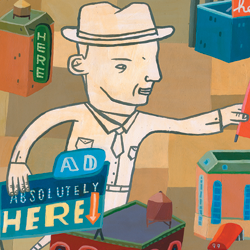 |
 Candy Adams,
Candy Adams,
CTSM, CME,
CEM, CMP, CMM,
is an independent exhibit-management
consultant, trainer, speaker, writer, and an Exhibitor conference
faculty member.
CandyAdams
@BoothMom.com
|
| |
 s the economy continues to slowly come back to life, many com-panies are beginning to loosen the corporate purse strings. And the return of more marketing dollars is a welcome relief for exhibit managers, who have spent years "doing more with less." s the economy continues to slowly come back to life, many com-panies are beginning to loosen the corporate purse strings. And the return of more marketing dollars is a welcome relief for exhibit managers, who have spent years "doing more with less."
If you're one of those exhibit managers, take a moment to look long and hard at your current exhibit. Chances are, your booth took a hit during the Great Recession, and it could likely use a reboot.
However, if you find yourself with the budget for a new build, don't use an old process to procure it. Myriad recession-era changes, such as downsizing, structural reorganization, corporate rebranding, etc., will all influence your request-for-proposal process, from who should be involved in the planning stages and vendor selection to the type of information you need to include in your request. So update your RFP, but also update your overall process, as it's a crucial piece in the proposal puzzle.
Use the Correct Documentation
There are three different documents that can be used to solicit a response from an exhibit house, depending on what you want to find out. The first, called a request for information (RFI), is the initial request made to vendors during the project-planning phase of procurement. Its purpose is to establish contact with a supplier and request general information about capabilities, procedures, etc. An RFI is sometimes followed by a more detailed RFP, based on your satisfaction with the vendor's responses to the RFI.
The second document, called a request for quotation (RFQ), is used to price quotes on off-the-shelf items (e.g., literature racks, table linens, pop-up exhibits, etc.) and exhibit services (e.g., exhibit transportation, installation-and-dismantle labor, etc.). An RFQ is not commonly used as a document to solicit design and build proposals. Instead, it basically boils down to the following three questions: Do you have product X? How much will it cost? When can I get it?
Finally, an RFP is a much more comprehensive document. It's used to request a full proposal from potential, prequalified suppliers by sharing information on the overall scope of the project, including detailed requirements. The key here is the word "detail." The chances of you getting spot-on proposals that will meet your needs will rise exponentially the more organized and concise the information provided in your RFP. That said, only you can determine what is important to your company and the project at hand, and prioritize accordingly.
For example, is it important to have an eye-popping design that will appeal to your target market? Or maybe you need an exhibit design that can be reconfigurable. Perhaps it's more important that the design meet all of your functional specifications. Also consider the price tag - will the initial cost to build the exhibit be the deciding factor on which bid you ultimately select? Or is it the ongoing cost of refurbishment?
Ultimately, it's up to you to identify the must-have elements and how they'll influence your decision-making process. To help you get started, visit www.ExhibitorWebLinks.com for a detailed list of elements commonly included in an RFP.
Assemble Your Team
Once you decide which document to use, you'll have to determine your team of stakeholders - the people who have a vested interest, or stake, in the success of your exhibit program. Typically, stakeholders include people from your company's marketing department (advertising or social-media managers, exhibit/event managers, marketing-communications managers, etc.). You may also want to include sales staff, namely those involved in the generation and ongoing management of the prospect sales cycle, as well as the person who manages the prospect database. Since the No. 1 reason most exhibitors give for participating in shows is to get qualified leads that they can convert to sales, the exhibit needs to be appealing enough to draw in your target market. And since trade shows are a large contributor to the lead pool, CRM managers are interested in not only the leads collected at shows, but also the process of gathering and qualifying those leads in the exhibit.
It's important to note that the team members will vary, depending on your company's procurement policy, the exhibit manager's ongoing communication with internal stakeholders for your current shows, and any stakeholders who may be involved in the future. For example, if your company is launching a new product that will be displayed in your exhibit, include staff from that particular product team in the RFP process. The team can provide valuable insight in terms of how that product should be displayed.
Additional staff members that sometimes get looped in (depending on the scope of the project and your company's preferences) include people in the procurement, finance, and legal departments. Whomever you decide to include, you'll want them to participate in the design process not only to get buy-in early on, but also so they can discuss their (or their department's) specific requirements.
Develop a Timeline
Assembling your RFP dream team and compiling and prioritizing its varied concerns into one document can be the most time-consuming and frustrating part of the exhibit-building process, depending on the availability, commitment, and flexibility of the team members. Thus, I find it's helpful to create a timeline for all those involved. When to start the planning process is determined by a number of factors, from the availability of budget to the target date of the trade show at which the exhibit will debut.
Other influencing factors include the size of the project, the availability of your stakeholders to participate in ongoing planning meetings, and the complexity of your internal contracting processes. Considering these variables, I subscribe to three rules of thumb for exhibit-build timeline minimums. I need:
 Two weeks between the distribution and return deadline of an RFI. Two weeks between the distribution and return deadline of an RFI.
 Three weeks between the distribution and return deadline of an RFP. Three weeks between the distribution and return deadline of an RFP.
 Four months (minimum) to compile and distribute an RFI and RFP, review proposals, select the supplier(s), negotiate the contract(s), and build a small-to-medium size exhibit. Four months (minimum) to compile and distribute an RFI and RFP, review proposals, select the supplier(s), negotiate the contract(s), and build a small-to-medium size exhibit.
For larger, more complex, or international exhibits, I've started planning up to a year in advance. To be safe, I recommend adding a few weeks to a month to your initial time estimate.
Disclose Your Budget
Beyond your stakeholders' individual requirements for the project, one RFP component that is likely non-negotiable is your budget. I'm continually surprised at how often I get asked, "Should we tell the exhibit house how much we have earmarked for our exhibit budget?" The short answer is "yes." Not disclosing at least a budgetary range for a new exhibit fabrication can be detrimental to your entire RFP process, especially if the proposals come back well over your budget. If that happens, you'll end up back at square one with nothing to show for your work.
My personal preference is to disclose at least 90 percent of the exhibitor's capital budget, and hold back 10 percent for contingency spending and upgrades. (Make sure that the bottom-line number provided in your RFPs includes any sales tax due based on where your new exhibit property will be used for the first time, as state taxes vary.)
For many exhibitors, especially those doing many shows per year, more important than the cost to design and fabricate the initial build is the ongoing cost to use the booth. Such costs include exhibit transportation, material handling, electrical, Internet, I&D labor, refurbishment, rigging, inventory management, and storage. Take those expenses into account when budgeting for your new exhibit.
Create a Comparison Matrix
Before releasing your RFP to your stakeholders for final review (and ultimately distributing it to the chosen list of suppliers), compile a matrix of the criteria you'll use to grade the proposals you receive, including how much importance to put on the various segments of the response. For example, maybe creative design and functional requirements are weighted at 60 percent, and all other segments garner 5 percent.
However you decide to assign worth, segment your RFP accordingly to make each proposal as simple to grade and compare as possible, and ask those responding to maintain the format you spell out in the RFP.
Keep it Ethical
There are several ethical considerations that come into play during the process. While your company's procurement department may have rules of its own, here are some of the guidelines I ask my clients to stick to when it comes to reviewing proposals:
 Determine if the proposals you receive will be considered final, semifinal, or up for rebid with the opportunity to match another vendor's (possibly lower) bid. Determine if the proposals you receive will be considered final, semifinal, or up for rebid with the opportunity to match another vendor's (possibly lower) bid.
 Determine if and/or how you
will disseminate the answers to project-specific questions posed by one vendor to other vendors who have received your RFP. Determine if and/or how you
will disseminate the answers to project-specific questions posed by one vendor to other vendors who have received your RFP.
 Agree that the stakeholders will not tell bidders which vendors the RFP was sent to, which vendors responded to it, and which vendors decided not to bid on the project. Agree that the stakeholders will not tell bidders which vendors the RFP was sent to, which vendors responded to it, and which vendors decided not to bid on the project.
 Don't divulge the winning bid or specifics of the winner's proposal to the losing bidders. Don't divulge the winning bid or specifics of the winner's proposal to the losing bidders.
Ethical considerations aside, writing
and distributing RFPs is a lengthy, time-consuming process. But by fighting the urge to simply send out a dated RFP, you're already closer to getting exactly what you want.e
|





 s the economy continues to slowly come back to life, many com-panies are beginning to loosen the corporate purse strings. And the return of more marketing dollars is a welcome relief for exhibit managers, who have spent years "doing more with less."
s the economy continues to slowly come back to life, many com-panies are beginning to loosen the corporate purse strings. And the return of more marketing dollars is a welcome relief for exhibit managers, who have spent years "doing more with less."


